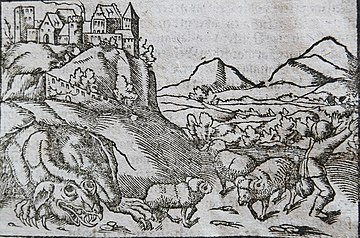Wawel Dragon
| Smok Wawelski | |
|---|---|

The Wawel dragon, in Sebastian Münster's Cosmographie Universalis (1544)
|
The Wawel Dragon (Polish: Smok Wawelski), also known as the Dragon of Wawel Hill, is a famous dragon in Polish folklore. His lair was in a cave at the foot of Wawel Hill on the bank of the Vistula River. Wawel Hill is in Kraków, which was then the capital of Poland. In some stories the dragon lived before the founding of the city, when the area was inhabited by farmers.
Wawel Cathedral and Kraków's Wawel Castle stand on Wawel Hill. In front of the entrance to the cathedral there are bones of creatures hanging on a chain, which were found and carried to the cathedral in medieval times as the remains of a dragon. It is believed that the world will come to its end when the bones will fall on the ground. The cathedral features a statue of the Wawel dragon and a plaque commemorating his defeat by Krakus, a Polish prince who, according to the plaque, founded the city and built his palace over the slain dragon's lair. The dragon's cave below the castle is now a popular tourist stop.
The oldest known telling of the story comes from the 13th century work of Bishop of Kraków and historian of Poland, Wincenty Kadłubek. According to his chronicle, the frightening monster appeared during the reign of King Krakus (lat. Gracchus). The dragon required weekly offerings of cattle, if not, the humans would have been devoured instead. In the hope of killing the dragon, Krakus called on his two sons, Lech and Krakus II. They could not, however, defeat the creature by hand, so they came up with a trick. They fed him a calf skin stuffed with smoldering sulfur causing his fiery death. Then the brothers argued about who deserves the honor for slaying the dragon. The older brother killed the younger brother Grakch (Krakus), and told that the dragon killed him. When he became king, his secret was revealed, and he got expelled from the country. The city was named in recognition of the brave and innocent Krakus.
...
Wikipedia
